HRMT20024 T1 2018 Annotated Bibliography: HRM in Hospitality
VerifiedAdded on 2023/06/13
|12
|2908
|275
Annotated Bibliography
AI Summary
This annotated bibliography comprises five peer-reviewed journal articles focusing on human resource management (HRM) planning within the hospitality sector. The articles examine various aspects, including challenges in HR planning, the role of strategic groups in HRM, strategic HR development approaches, HRM practices in the Indian hospitality sector, and the impact of HRM on hotel performance. Each annotation summarizes the article's purpose, methodology, key findings, and relevance to the hospitality industry, providing a comprehensive overview of current research and practices in HRM within this sector. Desklib offers a wealth of similar solved assignments and resources for students.
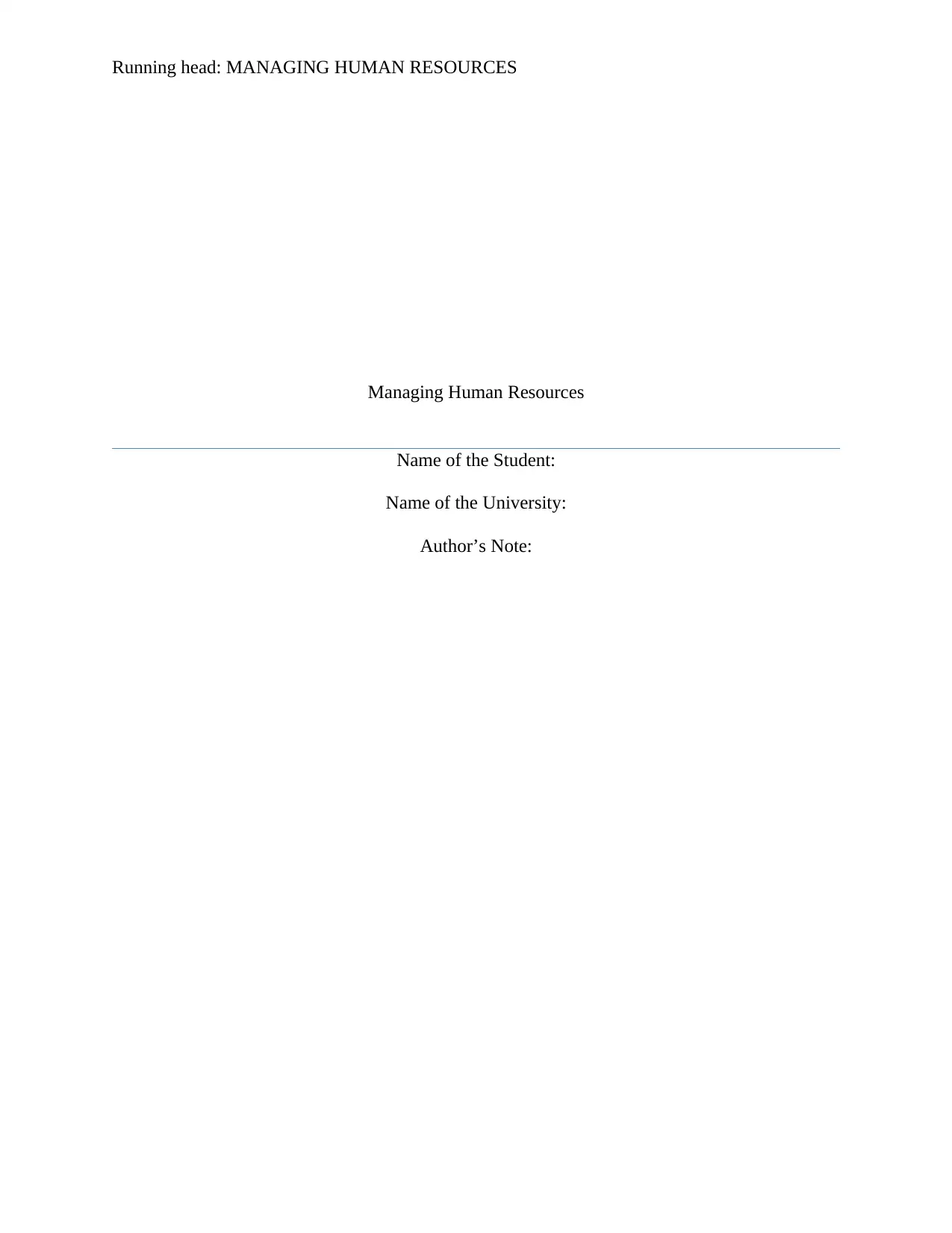
Running head: MANAGING HUMAN RESOURCES
Managing Human Resources
Name of the Student:
Name of the University:
Author’s Note:
Managing Human Resources
Name of the Student:
Name of the University:
Author’s Note:
Paraphrase This Document
Need a fresh take? Get an instant paraphrase of this document with our AI Paraphraser
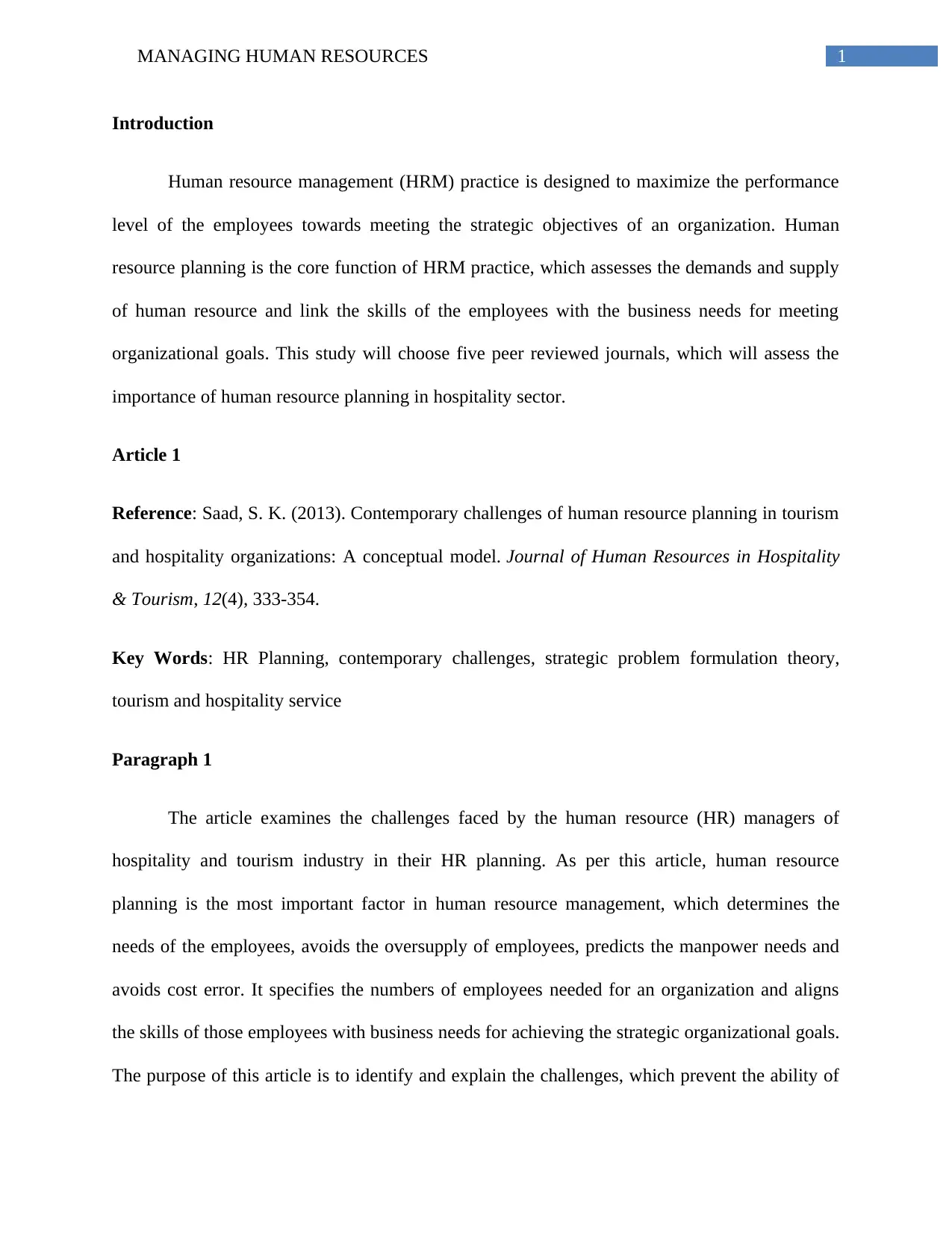
1MANAGING HUMAN RESOURCES
Introduction
Human resource management (HRM) practice is designed to maximize the performance
level of the employees towards meeting the strategic objectives of an organization. Human
resource planning is the core function of HRM practice, which assesses the demands and supply
of human resource and link the skills of the employees with the business needs for meeting
organizational goals. This study will choose five peer reviewed journals, which will assess the
importance of human resource planning in hospitality sector.
Article 1
Reference: Saad, S. K. (2013). Contemporary challenges of human resource planning in tourism
and hospitality organizations: A conceptual model. Journal of Human Resources in Hospitality
& Tourism, 12(4), 333-354.
Key Words: HR Planning, contemporary challenges, strategic problem formulation theory,
tourism and hospitality service
Paragraph 1
The article examines the challenges faced by the human resource (HR) managers of
hospitality and tourism industry in their HR planning. As per this article, human resource
planning is the most important factor in human resource management, which determines the
needs of the employees, avoids the oversupply of employees, predicts the manpower needs and
avoids cost error. It specifies the numbers of employees needed for an organization and aligns
the skills of those employees with business needs for achieving the strategic organizational goals.
The purpose of this article is to identify and explain the challenges, which prevent the ability of
Introduction
Human resource management (HRM) practice is designed to maximize the performance
level of the employees towards meeting the strategic objectives of an organization. Human
resource planning is the core function of HRM practice, which assesses the demands and supply
of human resource and link the skills of the employees with the business needs for meeting
organizational goals. This study will choose five peer reviewed journals, which will assess the
importance of human resource planning in hospitality sector.
Article 1
Reference: Saad, S. K. (2013). Contemporary challenges of human resource planning in tourism
and hospitality organizations: A conceptual model. Journal of Human Resources in Hospitality
& Tourism, 12(4), 333-354.
Key Words: HR Planning, contemporary challenges, strategic problem formulation theory,
tourism and hospitality service
Paragraph 1
The article examines the challenges faced by the human resource (HR) managers of
hospitality and tourism industry in their HR planning. As per this article, human resource
planning is the most important factor in human resource management, which determines the
needs of the employees, avoids the oversupply of employees, predicts the manpower needs and
avoids cost error. It specifies the numbers of employees needed for an organization and aligns
the skills of those employees with business needs for achieving the strategic organizational goals.
The purpose of this article is to identify and explain the challenges, which prevent the ability of
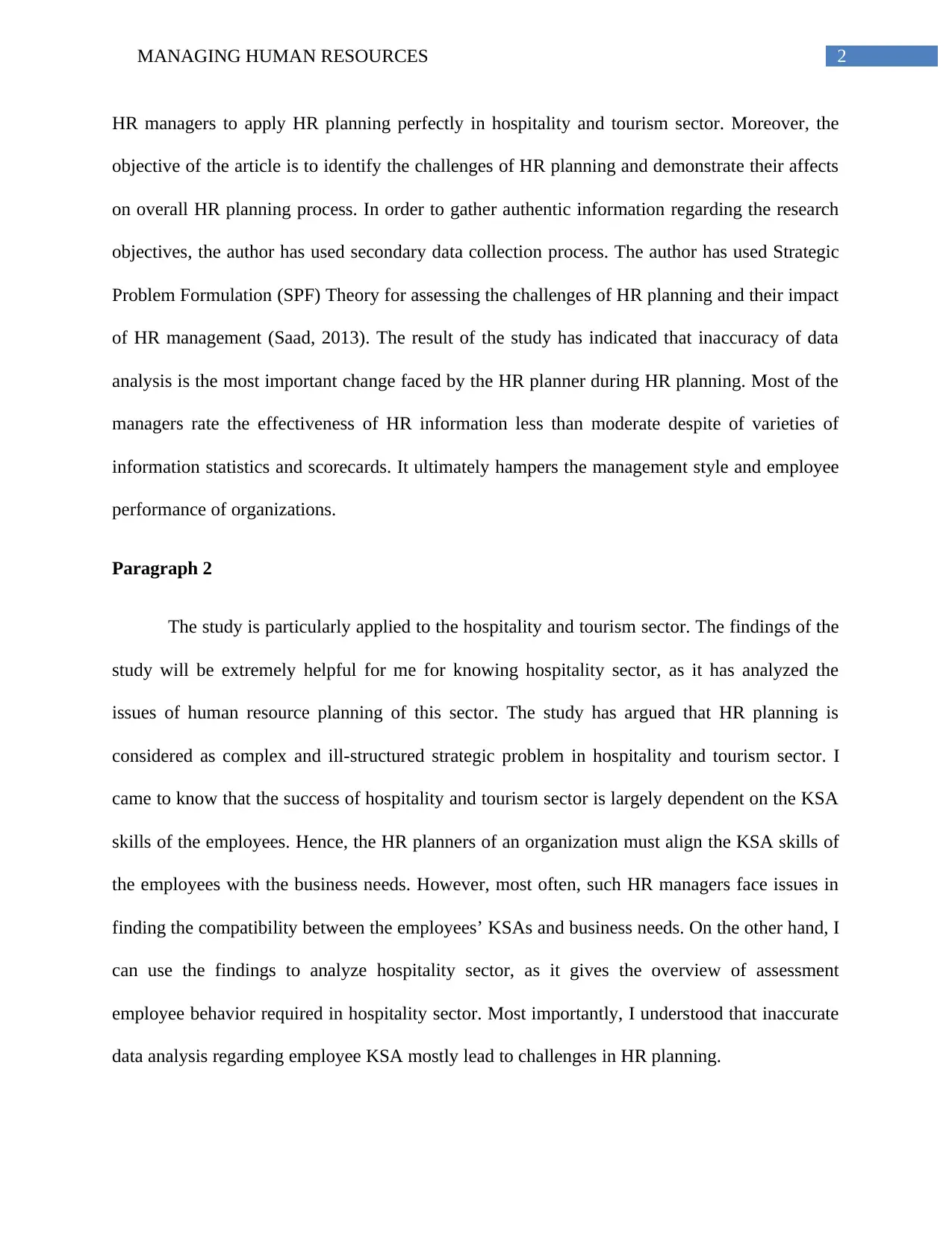
2MANAGING HUMAN RESOURCES
HR managers to apply HR planning perfectly in hospitality and tourism sector. Moreover, the
objective of the article is to identify the challenges of HR planning and demonstrate their affects
on overall HR planning process. In order to gather authentic information regarding the research
objectives, the author has used secondary data collection process. The author has used Strategic
Problem Formulation (SPF) Theory for assessing the challenges of HR planning and their impact
of HR management (Saad, 2013). The result of the study has indicated that inaccuracy of data
analysis is the most important change faced by the HR planner during HR planning. Most of the
managers rate the effectiveness of HR information less than moderate despite of varieties of
information statistics and scorecards. It ultimately hampers the management style and employee
performance of organizations.
Paragraph 2
The study is particularly applied to the hospitality and tourism sector. The findings of the
study will be extremely helpful for me for knowing hospitality sector, as it has analyzed the
issues of human resource planning of this sector. The study has argued that HR planning is
considered as complex and ill-structured strategic problem in hospitality and tourism sector. I
came to know that the success of hospitality and tourism sector is largely dependent on the KSA
skills of the employees. Hence, the HR planners of an organization must align the KSA skills of
the employees with the business needs. However, most often, such HR managers face issues in
finding the compatibility between the employees’ KSAs and business needs. On the other hand, I
can use the findings to analyze hospitality sector, as it gives the overview of assessment
employee behavior required in hospitality sector. Most importantly, I understood that inaccurate
data analysis regarding employee KSA mostly lead to challenges in HR planning.
HR managers to apply HR planning perfectly in hospitality and tourism sector. Moreover, the
objective of the article is to identify the challenges of HR planning and demonstrate their affects
on overall HR planning process. In order to gather authentic information regarding the research
objectives, the author has used secondary data collection process. The author has used Strategic
Problem Formulation (SPF) Theory for assessing the challenges of HR planning and their impact
of HR management (Saad, 2013). The result of the study has indicated that inaccuracy of data
analysis is the most important change faced by the HR planner during HR planning. Most of the
managers rate the effectiveness of HR information less than moderate despite of varieties of
information statistics and scorecards. It ultimately hampers the management style and employee
performance of organizations.
Paragraph 2
The study is particularly applied to the hospitality and tourism sector. The findings of the
study will be extremely helpful for me for knowing hospitality sector, as it has analyzed the
issues of human resource planning of this sector. The study has argued that HR planning is
considered as complex and ill-structured strategic problem in hospitality and tourism sector. I
came to know that the success of hospitality and tourism sector is largely dependent on the KSA
skills of the employees. Hence, the HR planners of an organization must align the KSA skills of
the employees with the business needs. However, most often, such HR managers face issues in
finding the compatibility between the employees’ KSAs and business needs. On the other hand, I
can use the findings to analyze hospitality sector, as it gives the overview of assessment
employee behavior required in hospitality sector. Most importantly, I understood that inaccurate
data analysis regarding employee KSA mostly lead to challenges in HR planning.
⊘ This is a preview!⊘
Do you want full access?
Subscribe today to unlock all pages.

Trusted by 1+ million students worldwide
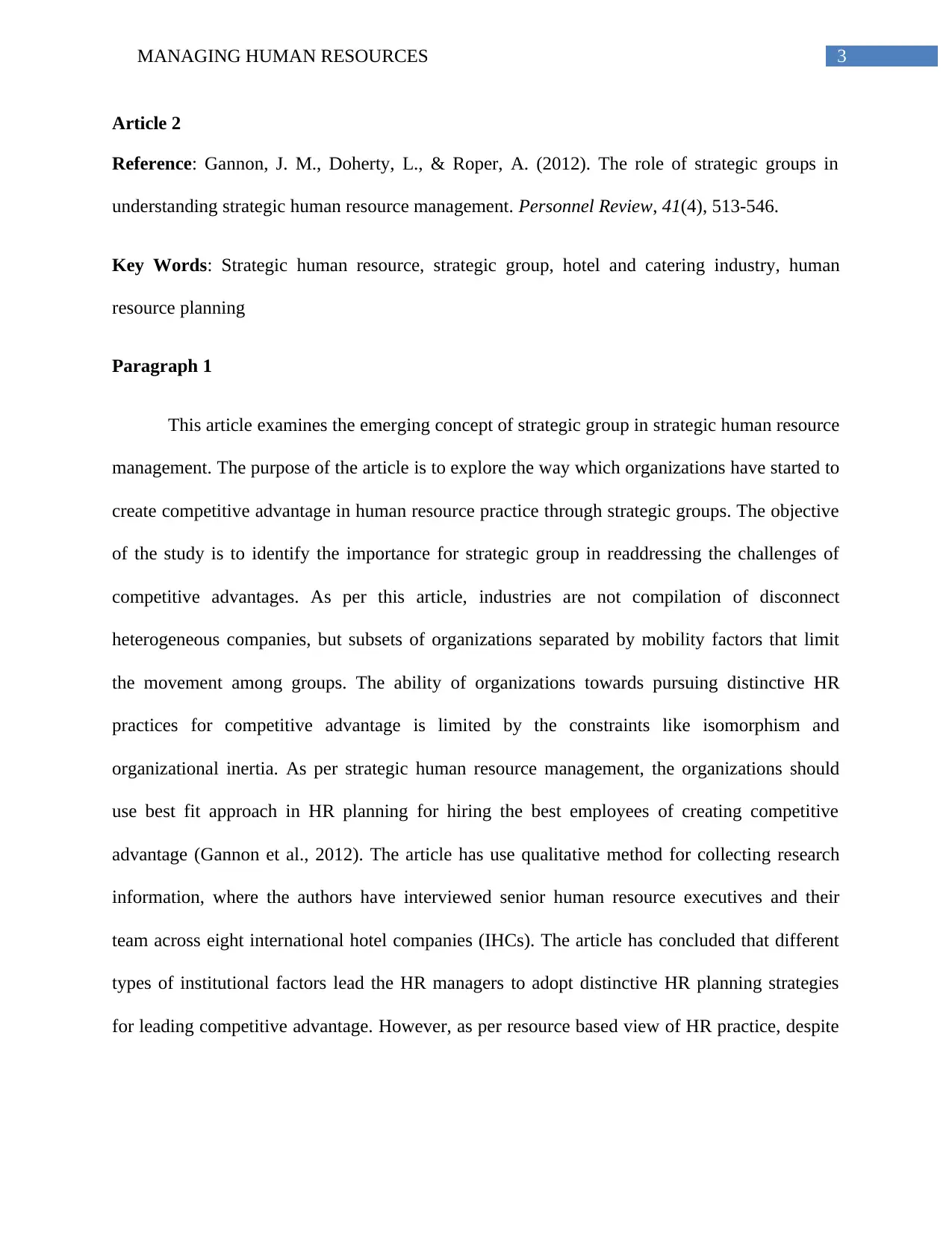
3MANAGING HUMAN RESOURCES
Article 2
Reference: Gannon, J. M., Doherty, L., & Roper, A. (2012). The role of strategic groups in
understanding strategic human resource management. Personnel Review, 41(4), 513-546.
Key Words: Strategic human resource, strategic group, hotel and catering industry, human
resource planning
Paragraph 1
This article examines the emerging concept of strategic group in strategic human resource
management. The purpose of the article is to explore the way which organizations have started to
create competitive advantage in human resource practice through strategic groups. The objective
of the study is to identify the importance for strategic group in readdressing the challenges of
competitive advantages. As per this article, industries are not compilation of disconnect
heterogeneous companies, but subsets of organizations separated by mobility factors that limit
the movement among groups. The ability of organizations towards pursuing distinctive HR
practices for competitive advantage is limited by the constraints like isomorphism and
organizational inertia. As per strategic human resource management, the organizations should
use best fit approach in HR planning for hiring the best employees of creating competitive
advantage (Gannon et al., 2012). The article has use qualitative method for collecting research
information, where the authors have interviewed senior human resource executives and their
team across eight international hotel companies (IHCs). The article has concluded that different
types of institutional factors lead the HR managers to adopt distinctive HR planning strategies
for leading competitive advantage. However, as per resource based view of HR practice, despite
Article 2
Reference: Gannon, J. M., Doherty, L., & Roper, A. (2012). The role of strategic groups in
understanding strategic human resource management. Personnel Review, 41(4), 513-546.
Key Words: Strategic human resource, strategic group, hotel and catering industry, human
resource planning
Paragraph 1
This article examines the emerging concept of strategic group in strategic human resource
management. The purpose of the article is to explore the way which organizations have started to
create competitive advantage in human resource practice through strategic groups. The objective
of the study is to identify the importance for strategic group in readdressing the challenges of
competitive advantages. As per this article, industries are not compilation of disconnect
heterogeneous companies, but subsets of organizations separated by mobility factors that limit
the movement among groups. The ability of organizations towards pursuing distinctive HR
practices for competitive advantage is limited by the constraints like isomorphism and
organizational inertia. As per strategic human resource management, the organizations should
use best fit approach in HR planning for hiring the best employees of creating competitive
advantage (Gannon et al., 2012). The article has use qualitative method for collecting research
information, where the authors have interviewed senior human resource executives and their
team across eight international hotel companies (IHCs). The article has concluded that different
types of institutional factors lead the HR managers to adopt distinctive HR planning strategies
for leading competitive advantage. However, as per resource based view of HR practice, despite
Paraphrase This Document
Need a fresh take? Get an instant paraphrase of this document with our AI Paraphraser
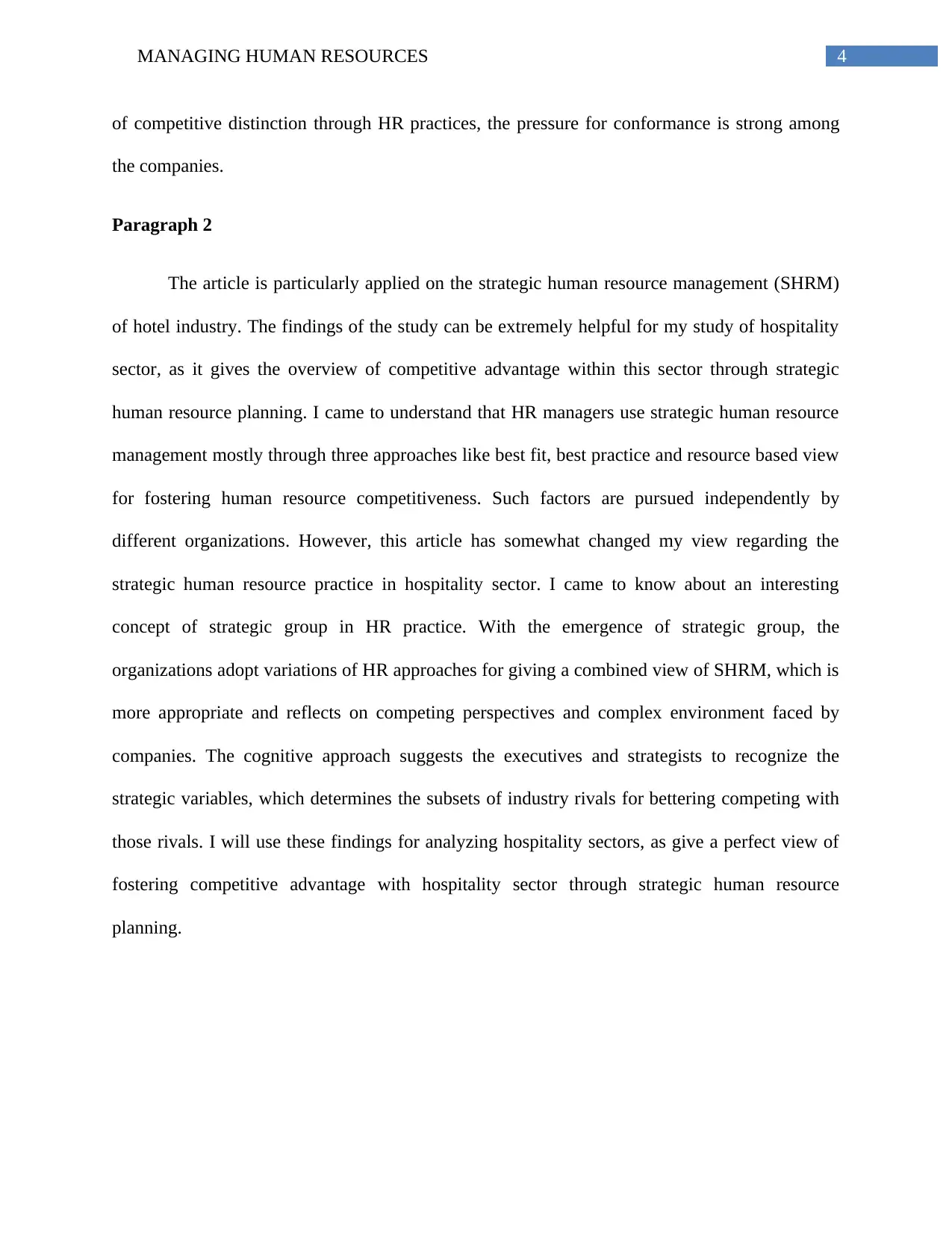
4MANAGING HUMAN RESOURCES
of competitive distinction through HR practices, the pressure for conformance is strong among
the companies.
Paragraph 2
The article is particularly applied on the strategic human resource management (SHRM)
of hotel industry. The findings of the study can be extremely helpful for my study of hospitality
sector, as it gives the overview of competitive advantage within this sector through strategic
human resource planning. I came to understand that HR managers use strategic human resource
management mostly through three approaches like best fit, best practice and resource based view
for fostering human resource competitiveness. Such factors are pursued independently by
different organizations. However, this article has somewhat changed my view regarding the
strategic human resource practice in hospitality sector. I came to know about an interesting
concept of strategic group in HR practice. With the emergence of strategic group, the
organizations adopt variations of HR approaches for giving a combined view of SHRM, which is
more appropriate and reflects on competing perspectives and complex environment faced by
companies. The cognitive approach suggests the executives and strategists to recognize the
strategic variables, which determines the subsets of industry rivals for bettering competing with
those rivals. I will use these findings for analyzing hospitality sectors, as give a perfect view of
fostering competitive advantage with hospitality sector through strategic human resource
planning.
of competitive distinction through HR practices, the pressure for conformance is strong among
the companies.
Paragraph 2
The article is particularly applied on the strategic human resource management (SHRM)
of hotel industry. The findings of the study can be extremely helpful for my study of hospitality
sector, as it gives the overview of competitive advantage within this sector through strategic
human resource planning. I came to understand that HR managers use strategic human resource
management mostly through three approaches like best fit, best practice and resource based view
for fostering human resource competitiveness. Such factors are pursued independently by
different organizations. However, this article has somewhat changed my view regarding the
strategic human resource practice in hospitality sector. I came to know about an interesting
concept of strategic group in HR practice. With the emergence of strategic group, the
organizations adopt variations of HR approaches for giving a combined view of SHRM, which is
more appropriate and reflects on competing perspectives and complex environment faced by
companies. The cognitive approach suggests the executives and strategists to recognize the
strategic variables, which determines the subsets of industry rivals for bettering competing with
those rivals. I will use these findings for analyzing hospitality sectors, as give a perfect view of
fostering competitive advantage with hospitality sector through strategic human resource
planning.
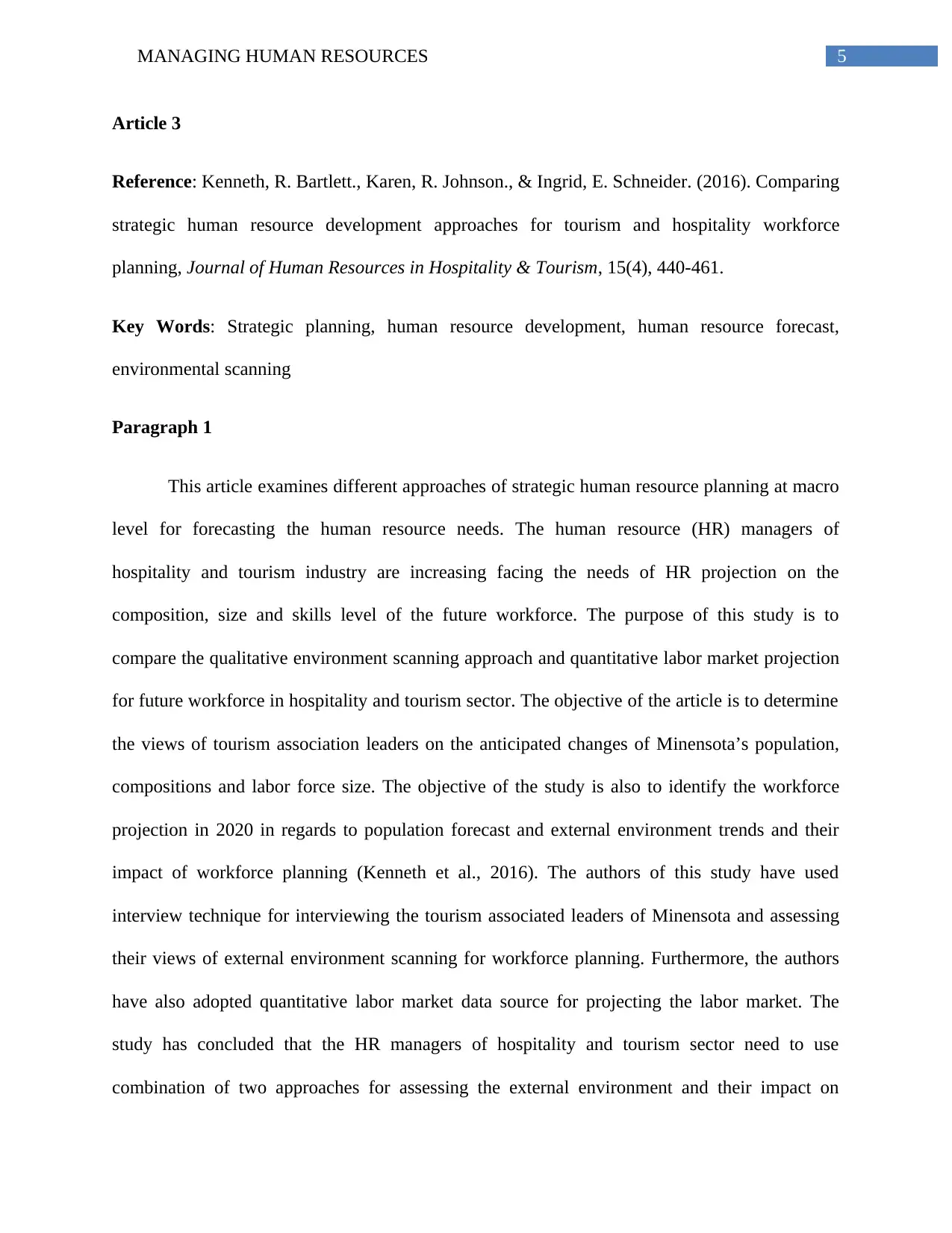
5MANAGING HUMAN RESOURCES
Article 3
Reference: Kenneth, R. Bartlett., Karen, R. Johnson., & Ingrid, E. Schneider. (2016). Comparing
strategic human resource development approaches for tourism and hospitality workforce
planning, Journal of Human Resources in Hospitality & Tourism, 15(4), 440-461.
Key Words: Strategic planning, human resource development, human resource forecast,
environmental scanning
Paragraph 1
This article examines different approaches of strategic human resource planning at macro
level for forecasting the human resource needs. The human resource (HR) managers of
hospitality and tourism industry are increasing facing the needs of HR projection on the
composition, size and skills level of the future workforce. The purpose of this study is to
compare the qualitative environment scanning approach and quantitative labor market projection
for future workforce in hospitality and tourism sector. The objective of the article is to determine
the views of tourism association leaders on the anticipated changes of Minensota’s population,
compositions and labor force size. The objective of the study is also to identify the workforce
projection in 2020 in regards to population forecast and external environment trends and their
impact of workforce planning (Kenneth et al., 2016). The authors of this study have used
interview technique for interviewing the tourism associated leaders of Minensota and assessing
their views of external environment scanning for workforce planning. Furthermore, the authors
have also adopted quantitative labor market data source for projecting the labor market. The
study has concluded that the HR managers of hospitality and tourism sector need to use
combination of two approaches for assessing the external environment and their impact on
Article 3
Reference: Kenneth, R. Bartlett., Karen, R. Johnson., & Ingrid, E. Schneider. (2016). Comparing
strategic human resource development approaches for tourism and hospitality workforce
planning, Journal of Human Resources in Hospitality & Tourism, 15(4), 440-461.
Key Words: Strategic planning, human resource development, human resource forecast,
environmental scanning
Paragraph 1
This article examines different approaches of strategic human resource planning at macro
level for forecasting the human resource needs. The human resource (HR) managers of
hospitality and tourism industry are increasing facing the needs of HR projection on the
composition, size and skills level of the future workforce. The purpose of this study is to
compare the qualitative environment scanning approach and quantitative labor market projection
for future workforce in hospitality and tourism sector. The objective of the article is to determine
the views of tourism association leaders on the anticipated changes of Minensota’s population,
compositions and labor force size. The objective of the study is also to identify the workforce
projection in 2020 in regards to population forecast and external environment trends and their
impact of workforce planning (Kenneth et al., 2016). The authors of this study have used
interview technique for interviewing the tourism associated leaders of Minensota and assessing
their views of external environment scanning for workforce planning. Furthermore, the authors
have also adopted quantitative labor market data source for projecting the labor market. The
study has concluded that the HR managers of hospitality and tourism sector need to use
combination of two approaches for assessing the external environment and their impact on
⊘ This is a preview!⊘
Do you want full access?
Subscribe today to unlock all pages.

Trusted by 1+ million students worldwide
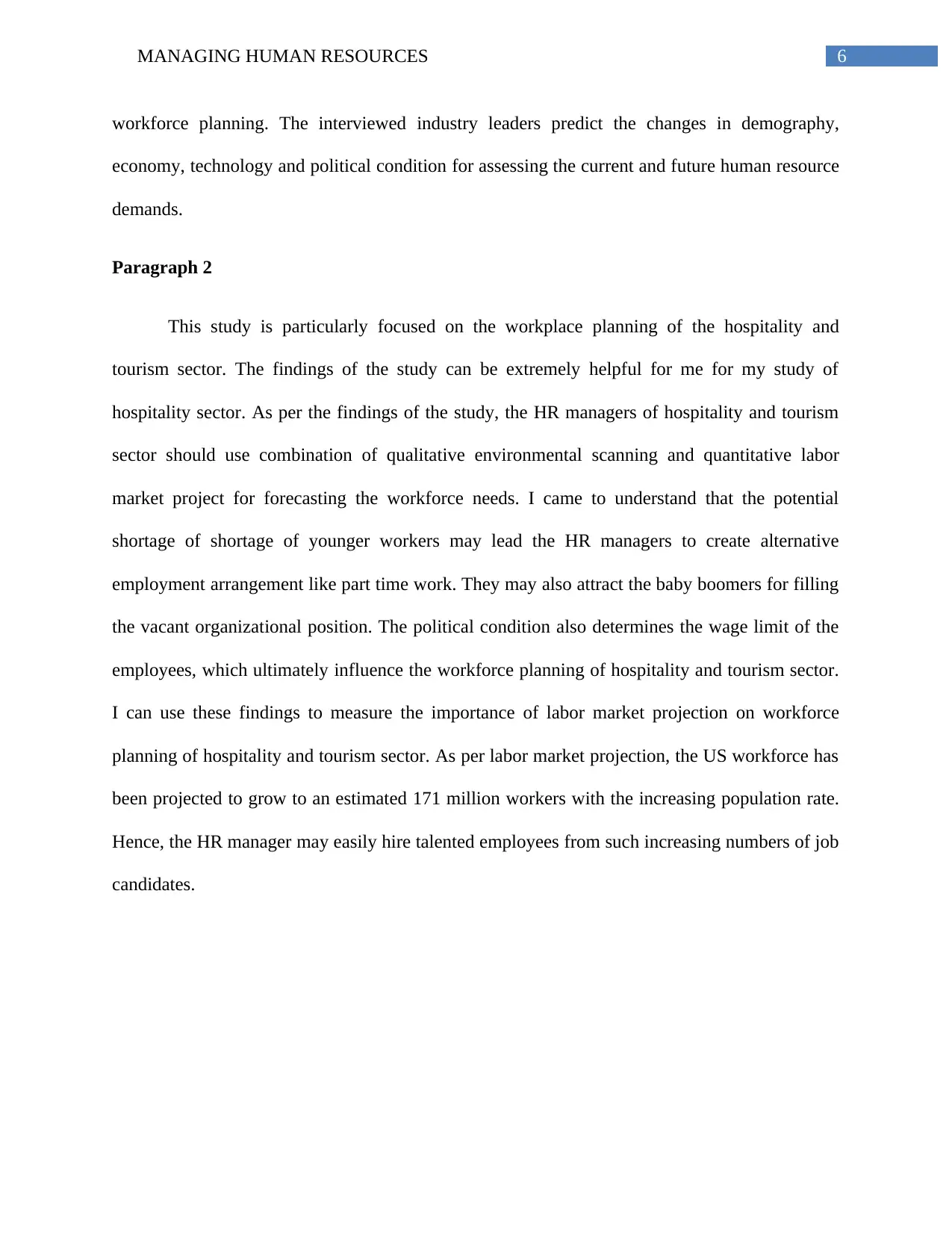
6MANAGING HUMAN RESOURCES
workforce planning. The interviewed industry leaders predict the changes in demography,
economy, technology and political condition for assessing the current and future human resource
demands.
Paragraph 2
This study is particularly focused on the workplace planning of the hospitality and
tourism sector. The findings of the study can be extremely helpful for me for my study of
hospitality sector. As per the findings of the study, the HR managers of hospitality and tourism
sector should use combination of qualitative environmental scanning and quantitative labor
market project for forecasting the workforce needs. I came to understand that the potential
shortage of shortage of younger workers may lead the HR managers to create alternative
employment arrangement like part time work. They may also attract the baby boomers for filling
the vacant organizational position. The political condition also determines the wage limit of the
employees, which ultimately influence the workforce planning of hospitality and tourism sector.
I can use these findings to measure the importance of labor market projection on workforce
planning of hospitality and tourism sector. As per labor market projection, the US workforce has
been projected to grow to an estimated 171 million workers with the increasing population rate.
Hence, the HR manager may easily hire talented employees from such increasing numbers of job
candidates.
workforce planning. The interviewed industry leaders predict the changes in demography,
economy, technology and political condition for assessing the current and future human resource
demands.
Paragraph 2
This study is particularly focused on the workplace planning of the hospitality and
tourism sector. The findings of the study can be extremely helpful for me for my study of
hospitality sector. As per the findings of the study, the HR managers of hospitality and tourism
sector should use combination of qualitative environmental scanning and quantitative labor
market project for forecasting the workforce needs. I came to understand that the potential
shortage of shortage of younger workers may lead the HR managers to create alternative
employment arrangement like part time work. They may also attract the baby boomers for filling
the vacant organizational position. The political condition also determines the wage limit of the
employees, which ultimately influence the workforce planning of hospitality and tourism sector.
I can use these findings to measure the importance of labor market projection on workforce
planning of hospitality and tourism sector. As per labor market projection, the US workforce has
been projected to grow to an estimated 171 million workers with the increasing population rate.
Hence, the HR manager may easily hire talented employees from such increasing numbers of job
candidates.
Paraphrase This Document
Need a fresh take? Get an instant paraphrase of this document with our AI Paraphraser
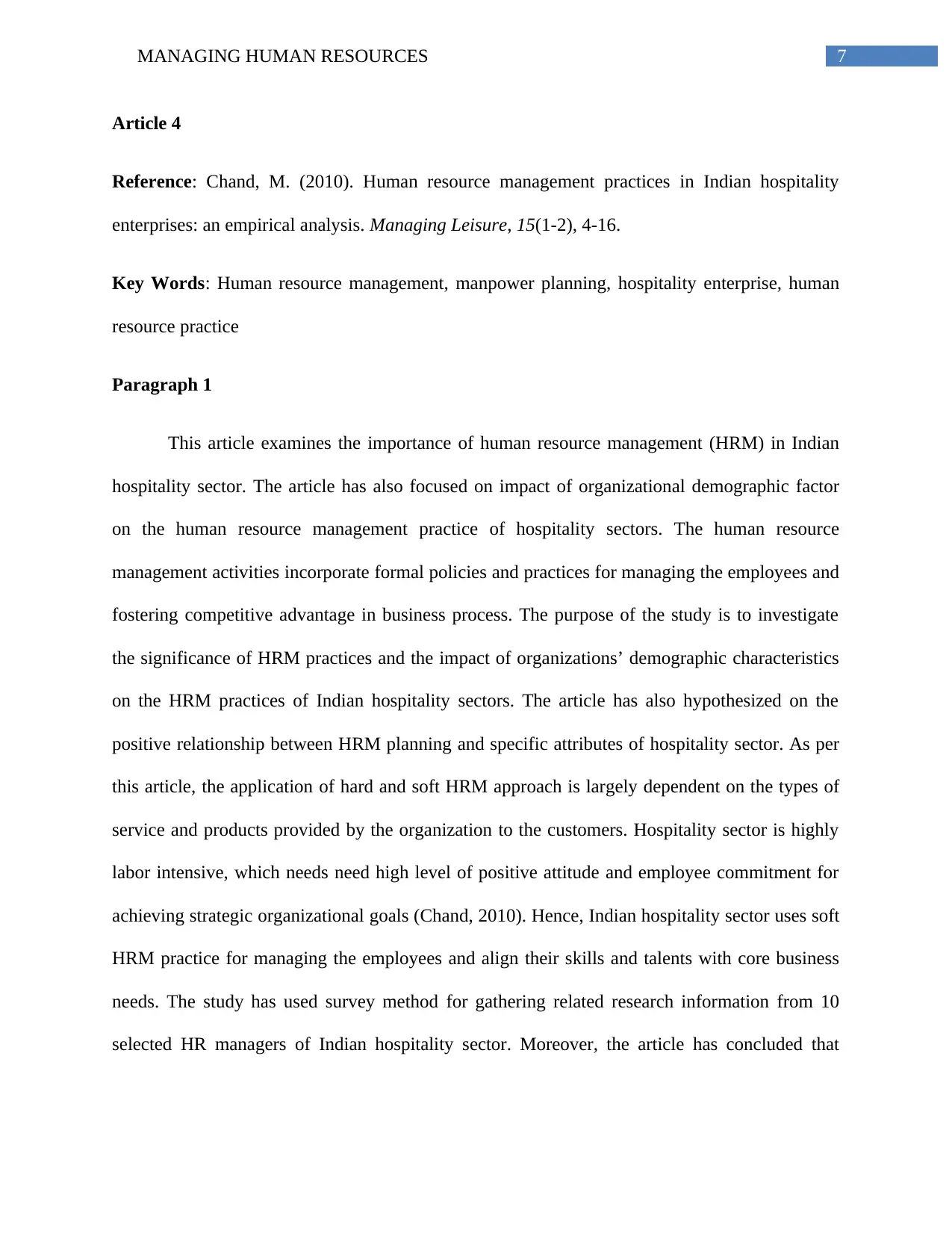
7MANAGING HUMAN RESOURCES
Article 4
Reference: Chand, M. (2010). Human resource management practices in Indian hospitality
enterprises: an empirical analysis. Managing Leisure, 15(1-2), 4-16.
Key Words: Human resource management, manpower planning, hospitality enterprise, human
resource practice
Paragraph 1
This article examines the importance of human resource management (HRM) in Indian
hospitality sector. The article has also focused on impact of organizational demographic factor
on the human resource management practice of hospitality sectors. The human resource
management activities incorporate formal policies and practices for managing the employees and
fostering competitive advantage in business process. The purpose of the study is to investigate
the significance of HRM practices and the impact of organizations’ demographic characteristics
on the HRM practices of Indian hospitality sectors. The article has also hypothesized on the
positive relationship between HRM planning and specific attributes of hospitality sector. As per
this article, the application of hard and soft HRM approach is largely dependent on the types of
service and products provided by the organization to the customers. Hospitality sector is highly
labor intensive, which needs need high level of positive attitude and employee commitment for
achieving strategic organizational goals (Chand, 2010). Hence, Indian hospitality sector uses soft
HRM practice for managing the employees and align their skills and talents with core business
needs. The study has used survey method for gathering related research information from 10
selected HR managers of Indian hospitality sector. Moreover, the article has concluded that
Article 4
Reference: Chand, M. (2010). Human resource management practices in Indian hospitality
enterprises: an empirical analysis. Managing Leisure, 15(1-2), 4-16.
Key Words: Human resource management, manpower planning, hospitality enterprise, human
resource practice
Paragraph 1
This article examines the importance of human resource management (HRM) in Indian
hospitality sector. The article has also focused on impact of organizational demographic factor
on the human resource management practice of hospitality sectors. The human resource
management activities incorporate formal policies and practices for managing the employees and
fostering competitive advantage in business process. The purpose of the study is to investigate
the significance of HRM practices and the impact of organizations’ demographic characteristics
on the HRM practices of Indian hospitality sectors. The article has also hypothesized on the
positive relationship between HRM planning and specific attributes of hospitality sector. As per
this article, the application of hard and soft HRM approach is largely dependent on the types of
service and products provided by the organization to the customers. Hospitality sector is highly
labor intensive, which needs need high level of positive attitude and employee commitment for
achieving strategic organizational goals (Chand, 2010). Hence, Indian hospitality sector uses soft
HRM practice for managing the employees and align their skills and talents with core business
needs. The study has used survey method for gathering related research information from 10
selected HR managers of Indian hospitality sector. Moreover, the article has concluded that
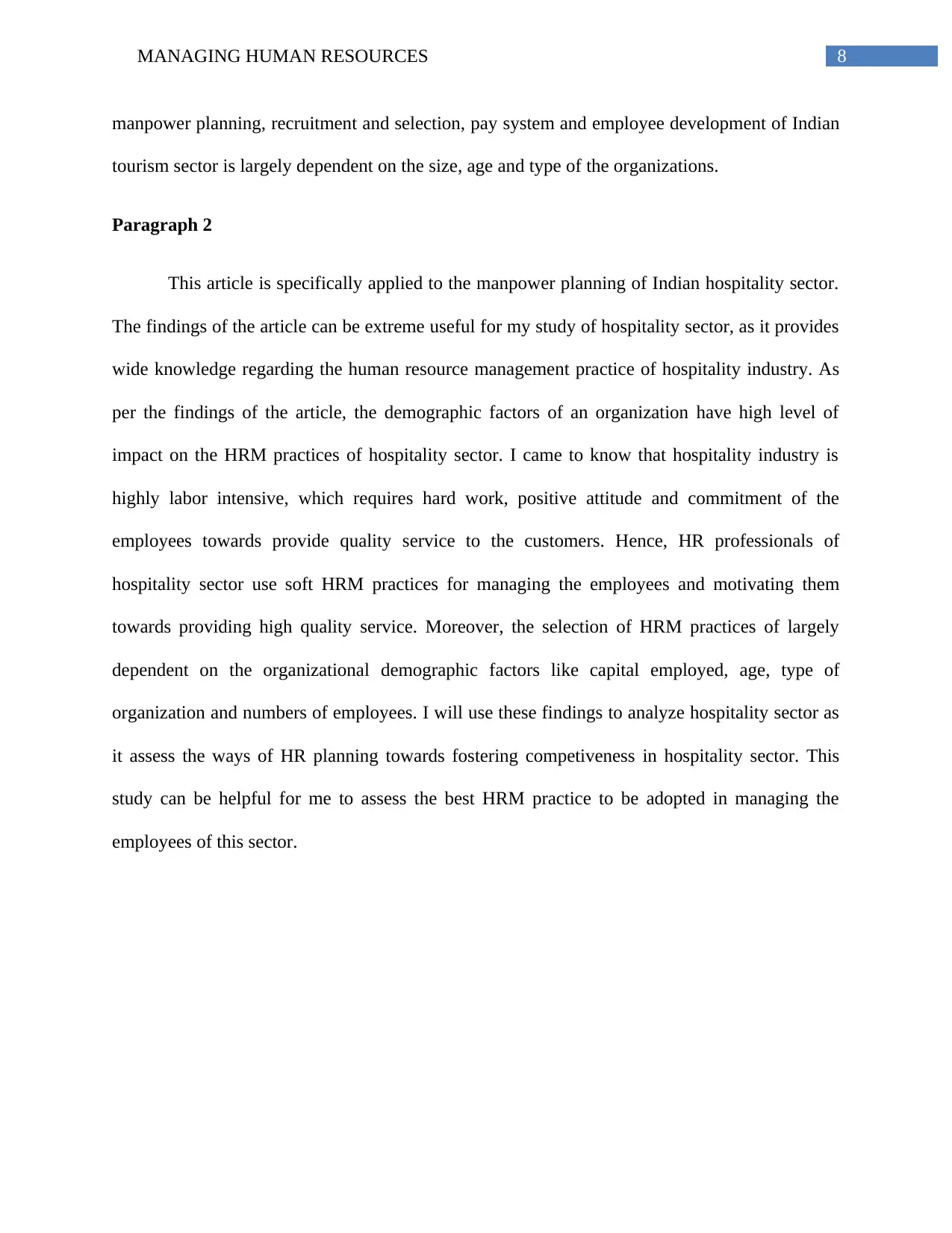
8MANAGING HUMAN RESOURCES
manpower planning, recruitment and selection, pay system and employee development of Indian
tourism sector is largely dependent on the size, age and type of the organizations.
Paragraph 2
This article is specifically applied to the manpower planning of Indian hospitality sector.
The findings of the article can be extreme useful for my study of hospitality sector, as it provides
wide knowledge regarding the human resource management practice of hospitality industry. As
per the findings of the article, the demographic factors of an organization have high level of
impact on the HRM practices of hospitality sector. I came to know that hospitality industry is
highly labor intensive, which requires hard work, positive attitude and commitment of the
employees towards provide quality service to the customers. Hence, HR professionals of
hospitality sector use soft HRM practices for managing the employees and motivating them
towards providing high quality service. Moreover, the selection of HRM practices of largely
dependent on the organizational demographic factors like capital employed, age, type of
organization and numbers of employees. I will use these findings to analyze hospitality sector as
it assess the ways of HR planning towards fostering competiveness in hospitality sector. This
study can be helpful for me to assess the best HRM practice to be adopted in managing the
employees of this sector.
manpower planning, recruitment and selection, pay system and employee development of Indian
tourism sector is largely dependent on the size, age and type of the organizations.
Paragraph 2
This article is specifically applied to the manpower planning of Indian hospitality sector.
The findings of the article can be extreme useful for my study of hospitality sector, as it provides
wide knowledge regarding the human resource management practice of hospitality industry. As
per the findings of the article, the demographic factors of an organization have high level of
impact on the HRM practices of hospitality sector. I came to know that hospitality industry is
highly labor intensive, which requires hard work, positive attitude and commitment of the
employees towards provide quality service to the customers. Hence, HR professionals of
hospitality sector use soft HRM practices for managing the employees and motivating them
towards providing high quality service. Moreover, the selection of HRM practices of largely
dependent on the organizational demographic factors like capital employed, age, type of
organization and numbers of employees. I will use these findings to analyze hospitality sector as
it assess the ways of HR planning towards fostering competiveness in hospitality sector. This
study can be helpful for me to assess the best HRM practice to be adopted in managing the
employees of this sector.
⊘ This is a preview!⊘
Do you want full access?
Subscribe today to unlock all pages.

Trusted by 1+ million students worldwide
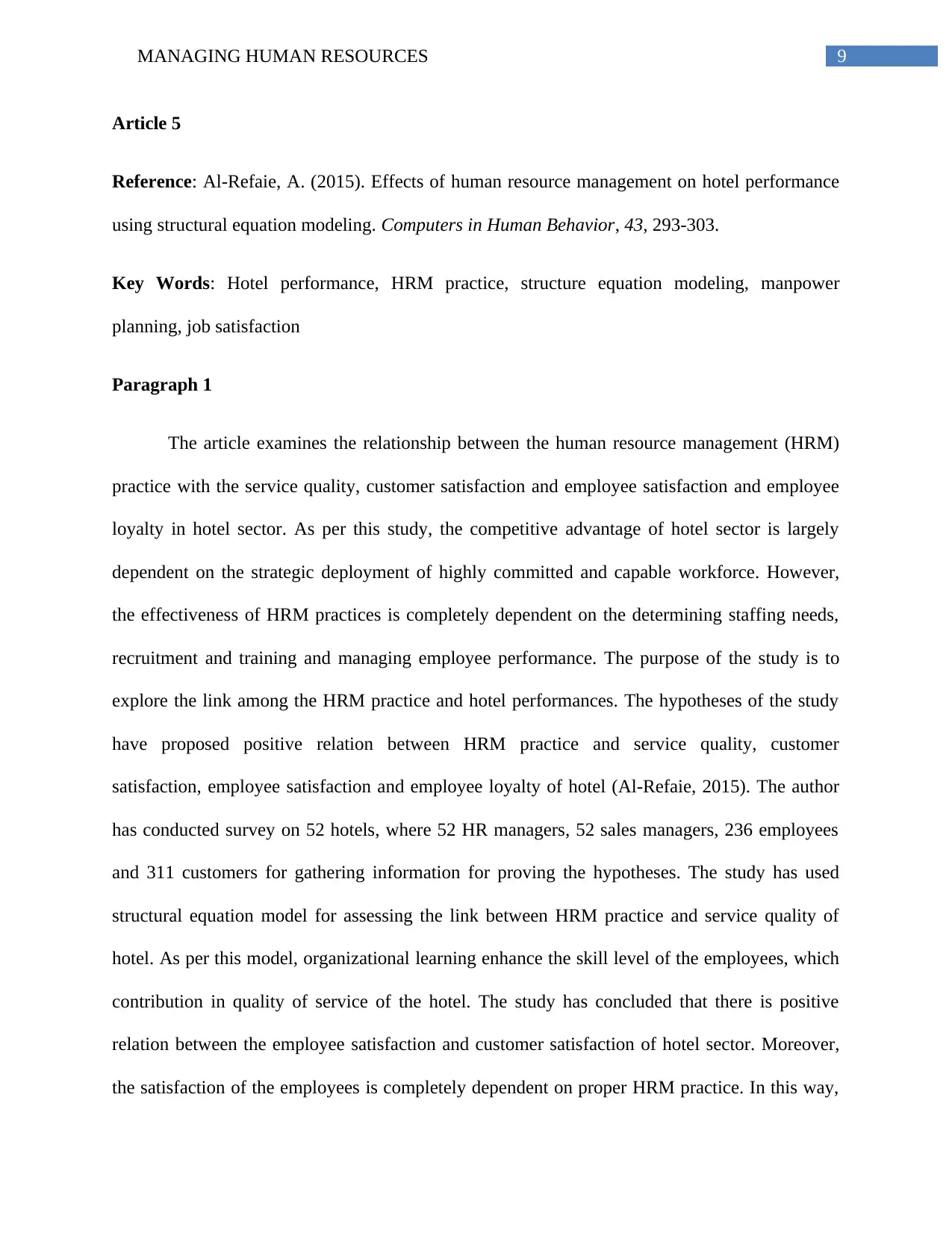
9MANAGING HUMAN RESOURCES
Article 5
Reference: Al-Refaie, A. (2015). Effects of human resource management on hotel performance
using structural equation modeling. Computers in Human Behavior, 43, 293-303.
Key Words: Hotel performance, HRM practice, structure equation modeling, manpower
planning, job satisfaction
Paragraph 1
The article examines the relationship between the human resource management (HRM)
practice with the service quality, customer satisfaction and employee satisfaction and employee
loyalty in hotel sector. As per this study, the competitive advantage of hotel sector is largely
dependent on the strategic deployment of highly committed and capable workforce. However,
the effectiveness of HRM practices is completely dependent on the determining staffing needs,
recruitment and training and managing employee performance. The purpose of the study is to
explore the link among the HRM practice and hotel performances. The hypotheses of the study
have proposed positive relation between HRM practice and service quality, customer
satisfaction, employee satisfaction and employee loyalty of hotel (Al-Refaie, 2015). The author
has conducted survey on 52 hotels, where 52 HR managers, 52 sales managers, 236 employees
and 311 customers for gathering information for proving the hypotheses. The study has used
structural equation model for assessing the link between HRM practice and service quality of
hotel. As per this model, organizational learning enhance the skill level of the employees, which
contribution in quality of service of the hotel. The study has concluded that there is positive
relation between the employee satisfaction and customer satisfaction of hotel sector. Moreover,
the satisfaction of the employees is completely dependent on proper HRM practice. In this way,
Article 5
Reference: Al-Refaie, A. (2015). Effects of human resource management on hotel performance
using structural equation modeling. Computers in Human Behavior, 43, 293-303.
Key Words: Hotel performance, HRM practice, structure equation modeling, manpower
planning, job satisfaction
Paragraph 1
The article examines the relationship between the human resource management (HRM)
practice with the service quality, customer satisfaction and employee satisfaction and employee
loyalty in hotel sector. As per this study, the competitive advantage of hotel sector is largely
dependent on the strategic deployment of highly committed and capable workforce. However,
the effectiveness of HRM practices is completely dependent on the determining staffing needs,
recruitment and training and managing employee performance. The purpose of the study is to
explore the link among the HRM practice and hotel performances. The hypotheses of the study
have proposed positive relation between HRM practice and service quality, customer
satisfaction, employee satisfaction and employee loyalty of hotel (Al-Refaie, 2015). The author
has conducted survey on 52 hotels, where 52 HR managers, 52 sales managers, 236 employees
and 311 customers for gathering information for proving the hypotheses. The study has used
structural equation model for assessing the link between HRM practice and service quality of
hotel. As per this model, organizational learning enhance the skill level of the employees, which
contribution in quality of service of the hotel. The study has concluded that there is positive
relation between the employee satisfaction and customer satisfaction of hotel sector. Moreover,
the satisfaction of the employees is completely dependent on proper HRM practice. In this way,
Paraphrase This Document
Need a fresh take? Get an instant paraphrase of this document with our AI Paraphraser
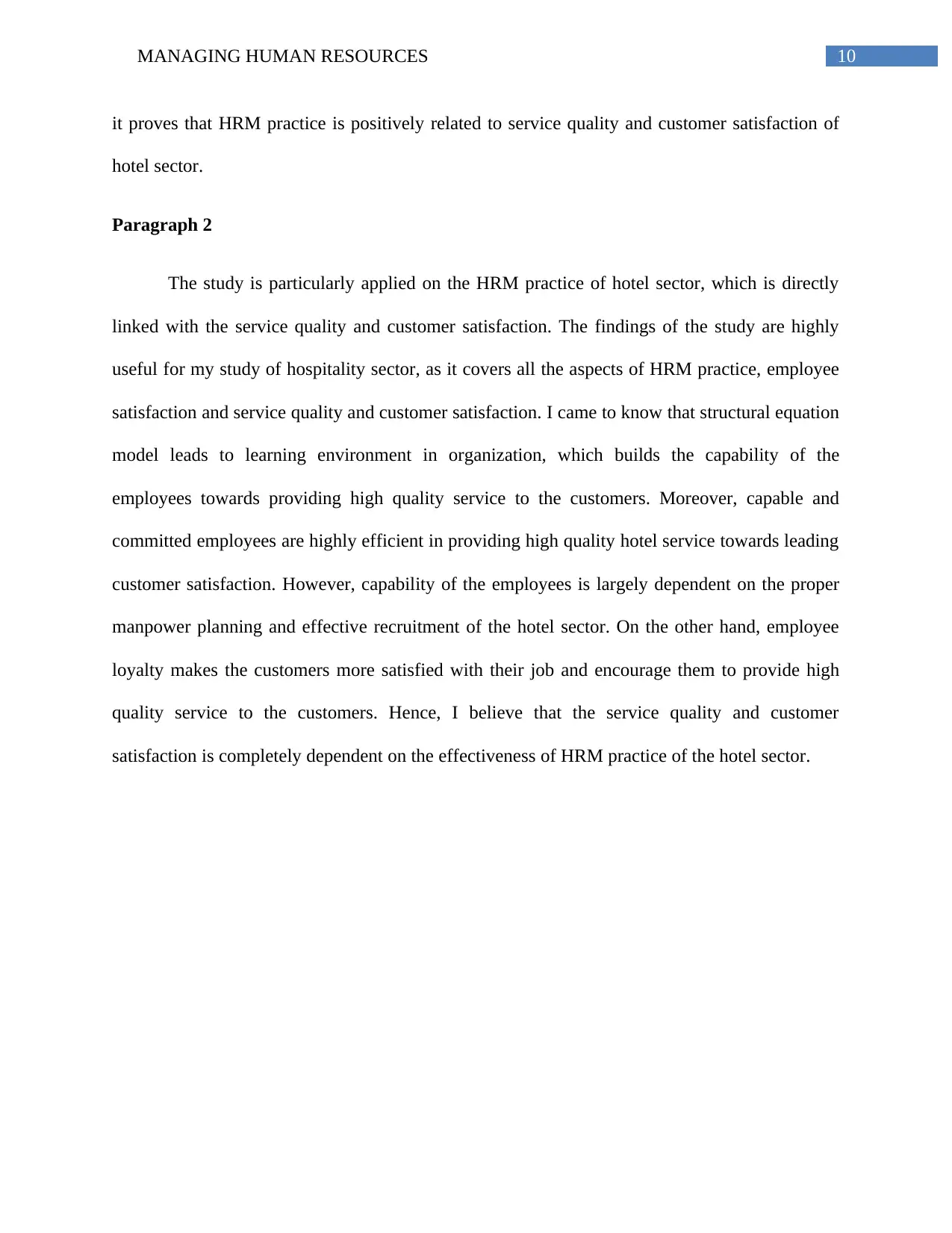
10MANAGING HUMAN RESOURCES
it proves that HRM practice is positively related to service quality and customer satisfaction of
hotel sector.
Paragraph 2
The study is particularly applied on the HRM practice of hotel sector, which is directly
linked with the service quality and customer satisfaction. The findings of the study are highly
useful for my study of hospitality sector, as it covers all the aspects of HRM practice, employee
satisfaction and service quality and customer satisfaction. I came to know that structural equation
model leads to learning environment in organization, which builds the capability of the
employees towards providing high quality service to the customers. Moreover, capable and
committed employees are highly efficient in providing high quality hotel service towards leading
customer satisfaction. However, capability of the employees is largely dependent on the proper
manpower planning and effective recruitment of the hotel sector. On the other hand, employee
loyalty makes the customers more satisfied with their job and encourage them to provide high
quality service to the customers. Hence, I believe that the service quality and customer
satisfaction is completely dependent on the effectiveness of HRM practice of the hotel sector.
it proves that HRM practice is positively related to service quality and customer satisfaction of
hotel sector.
Paragraph 2
The study is particularly applied on the HRM practice of hotel sector, which is directly
linked with the service quality and customer satisfaction. The findings of the study are highly
useful for my study of hospitality sector, as it covers all the aspects of HRM practice, employee
satisfaction and service quality and customer satisfaction. I came to know that structural equation
model leads to learning environment in organization, which builds the capability of the
employees towards providing high quality service to the customers. Moreover, capable and
committed employees are highly efficient in providing high quality hotel service towards leading
customer satisfaction. However, capability of the employees is largely dependent on the proper
manpower planning and effective recruitment of the hotel sector. On the other hand, employee
loyalty makes the customers more satisfied with their job and encourage them to provide high
quality service to the customers. Hence, I believe that the service quality and customer
satisfaction is completely dependent on the effectiveness of HRM practice of the hotel sector.
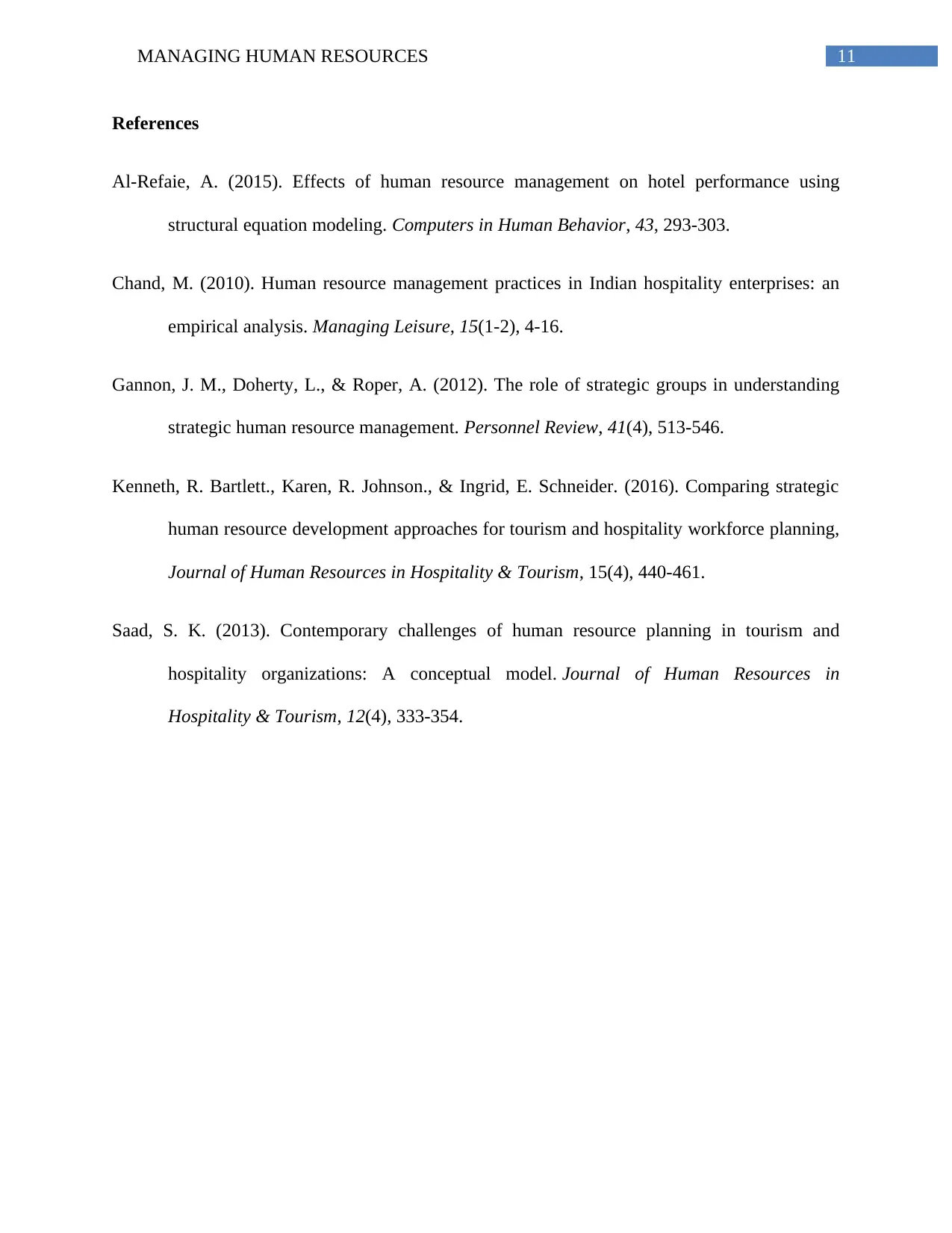
11MANAGING HUMAN RESOURCES
References
Al-Refaie, A. (2015). Effects of human resource management on hotel performance using
structural equation modeling. Computers in Human Behavior, 43, 293-303.
Chand, M. (2010). Human resource management practices in Indian hospitality enterprises: an
empirical analysis. Managing Leisure, 15(1-2), 4-16.
Gannon, J. M., Doherty, L., & Roper, A. (2012). The role of strategic groups in understanding
strategic human resource management. Personnel Review, 41(4), 513-546.
Kenneth, R. Bartlett., Karen, R. Johnson., & Ingrid, E. Schneider. (2016). Comparing strategic
human resource development approaches for tourism and hospitality workforce planning,
Journal of Human Resources in Hospitality & Tourism, 15(4), 440-461.
Saad, S. K. (2013). Contemporary challenges of human resource planning in tourism and
hospitality organizations: A conceptual model. Journal of Human Resources in
Hospitality & Tourism, 12(4), 333-354.
References
Al-Refaie, A. (2015). Effects of human resource management on hotel performance using
structural equation modeling. Computers in Human Behavior, 43, 293-303.
Chand, M. (2010). Human resource management practices in Indian hospitality enterprises: an
empirical analysis. Managing Leisure, 15(1-2), 4-16.
Gannon, J. M., Doherty, L., & Roper, A. (2012). The role of strategic groups in understanding
strategic human resource management. Personnel Review, 41(4), 513-546.
Kenneth, R. Bartlett., Karen, R. Johnson., & Ingrid, E. Schneider. (2016). Comparing strategic
human resource development approaches for tourism and hospitality workforce planning,
Journal of Human Resources in Hospitality & Tourism, 15(4), 440-461.
Saad, S. K. (2013). Contemporary challenges of human resource planning in tourism and
hospitality organizations: A conceptual model. Journal of Human Resources in
Hospitality & Tourism, 12(4), 333-354.
⊘ This is a preview!⊘
Do you want full access?
Subscribe today to unlock all pages.

Trusted by 1+ million students worldwide
1 out of 12
Related Documents
Your All-in-One AI-Powered Toolkit for Academic Success.
+13062052269
info@desklib.com
Available 24*7 on WhatsApp / Email
![[object Object]](/_next/static/media/star-bottom.7253800d.svg)
Unlock your academic potential
Copyright © 2020–2025 A2Z Services. All Rights Reserved. Developed and managed by ZUCOL.




